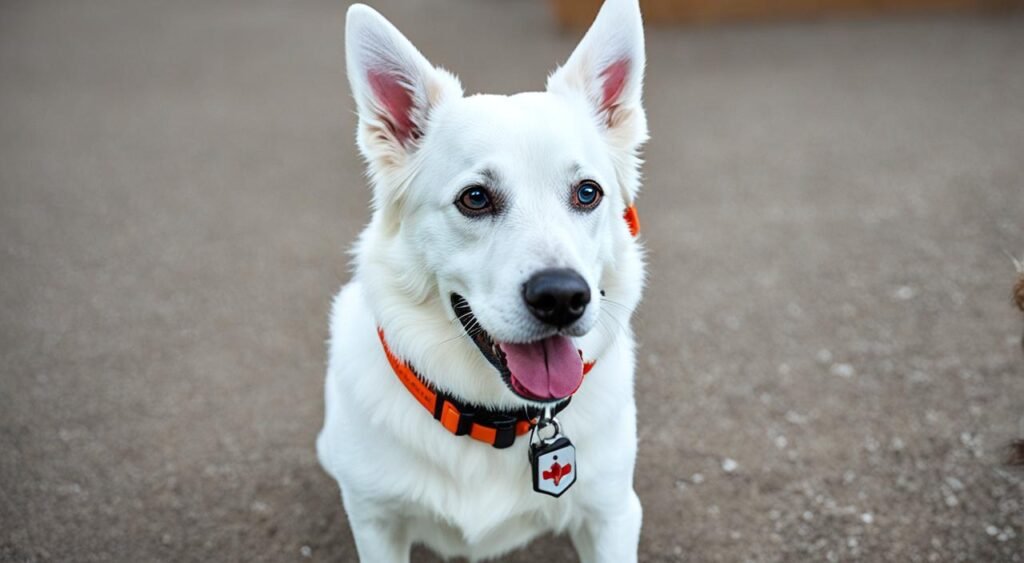Deafness can affect dogs at any point in their lives. Owners need to know how to care for them. This is especially true for dogs who are born deaf or become deaf later on. There are steps you can take to make sure they are happy and healthy.
Responsible pet ownership involves changing how you communicate. It also means making sure your home is a safe place for your deaf dog. In this article, we’ll look at ways to help your deaf dog. We’ll discuss training, better ways to talk with them, safety tips, and how to make their lives more interesting.
Key Takeaways:
- Deafness in dogs can occur at any stage of life and can be inherited or acquired.
- Signs of deafness in dogs include an inability to respond to verbal commands, ear infections, and disorientation in senior dogs.
- Tagging your deaf dog and using custom tags or vests with “I am deaf” can raise public awareness and help keep your dog safe.
- Using hand signals, including American Sign Language gestures, is crucial for effective communication with deaf dogs.
- Being attentive to your dog’s needs and providing safety precautions are essential for their well-being.
- Keeping your deaf dog on a leash or in a fenced yard can prevent accidents and wandering.
- Enriching your deaf dog’s environment with scents can enhance their sensory stimulation and overall well-being.
Tagging Your Deaf Dog for Safety
Making sure your deaf dog is safe is very important. Tags and identification are key to this. They let people know your dog is special and needs extra care. Custom tags can say “I am deaf,” and this tells others right away.
Don’t just use tags, though. Leash sleeves or vests that also say “I am deaf” are a great idea. This makes it very clear that your dog is deaf and needs special handling. It can prevent problems and help keep your dog safe.
Custom tags and specialized identification gear not only protect your deaf dog but also raise awareness and educate others about the unique needs of deaf dogs.
| Benefits of Tagging Your Deaf Dog | How It Enhances Safety |
|---|---|
| Raises awareness for deaf dogs | Prevents miscommunication and potentially dangerous encounters with unfamiliar individuals |
| Facilitates understanding and patience | Enables others to adapt their behavior and approach when interacting with your dog |
| Promotes a sense of community | Encourages fellow dog owners and members of the public to be mindful and considerate |
| Provides peace of mind | Reduces the risk of your deaf dog being startled or frightened by sudden movements or loud noises |
Always protect your deaf dog and help spread awareness. Use special tags, sleeves, or vests. This not only helps your dog but also makes your community better and more understanding.
Using Hand Signals to Communicate
Verbal commands don’t work with deaf dogs. But, hand signals are an effective way to talk with them. They help build a strong connection between you and your dog.
You can use American Sign Language (ASL) or simple hand signals. It’s important to be consistent when using these. Dogs learn best through repeated associations.
Avoid using gestures that look too similar. Clear signals are key to preventing confusion. This way, your dog can easily understand what you’re asking.
Basic commands like sit, come, and down, can be taught with hand motions. For sitting, move your hand from shoulder height down quickly. Your dog will learn to sit with this signal.
Always praise your dog when they get a signal right. Use treats or verbal praise. This positive feedback strengthens the link between the gesture and the action.
“Using hand signals to communicate with a deaf dog not only allows for effective communication, but it also deepens the bond between you and your furry friend.”
Teaching a deaf dog with hand signals needs patience and consistency. But with time, you’ll see your dog catching on to your signals. Using hand signals is a great way to communicate with them.
The Power of Non-Verbal Communication
Hand signals are key in training deaf dogs. They help you reach and understand your pet. This enhances the relationship between you and your dog.
By using hand signals, you can overcome the obstacle of deafness. You and your dog can share a language that is silent but understood. This deepens your bond and trust.
ASL gestures make communication clear and universal among deaf dog owners. It includes you in a group focused on caring for deaf dogs.
Training with hand signals is a rewarding investment. Your dog will be well-behaved and attentive. You, in turn, will feel closer to your beloved pet.
Being Attentive to Their Needs
It’s key to watch out for a hearing-impaired dog. They depend on their human for safety since they can’t hear dangers. Things like dogs barking or cars honking might go unnoticed by them. Watch where they are and use things like vibrating collars to warn them of these risks. Being on top of these things helps keep them out of harm’s way.
Keeping a deaf dog in your eyesight is very helpful. This means watching over them when they’re in the yard or during a walk. Also, use things like hand signals or flashing lights to warn them. These ways of communicating keep them from danger without the need for sounds.
A vibrating collar can also be a great tool. They buzz to alert the dog, especially when used with clear signals. This teaches the dog what the buzz means. But, it’s critical to train them to the collar correctly. You want to avoid making them scared of it.
Being responsive to a deaf dog’s needs means actively looking out for them and finding ways to communicate. By staying sharp and using tools like vibrating collars, you can help keep them safe and sound.
| Deaf Dog Safety Tips |
|---|
| 1. Always keep your deaf dog in sight to monitor their movements. |
| 2. Use visual cues, such as hand gestures or flashing lights, to get their attention and alert them to potential dangers. |
| 3. Consider using a vibrating collar to provide tactile alerts and associate them with specific commands or potential dangers. |
| 4. Introduce and use the vibrating collar properly to avoid causing fear or anxiety in the dog. |
Providing Safety Precautions

Keeping your deaf dog safe is a top priority. Here are some essential safety tips:
- Keep deaf dogs on leash: Always leash your deaf dog outside your secure yard. It stops them from wandering into danger.
- Secure fenced yards: Check your fence for any openings. Since they can’t hear, a tight fence is crucial. It keeps them from getting lost or hurt.
- Extra caution during walks: Be extra careful when out with your deaf dog around cars or crowded places. Use a leash and stay alert.
Deaf dogs don’t hear your commands. So, it’s key to keep them safe at all times.
For more safety, you might use a vibrating collar. Or, consider a bright leash or harness to help others spot your dog better.
With these steps, you’re making a safer world for your deaf dog. This brings peace of mind for both of you.
Enriching Their Senses
Deaf dogs rely a lot on their sense of smell. It’s very important for their day-to-day life. Enriching their environment with various scents can really boost their happiness and life quality.
Using scents like lavender or cinnamon is a great start. These smells offer joy to deaf dogs and stimulate their senses. You can add them to their bedding or toys for a comforting effect.
Enriching a deaf dog’s world with wonderful scents significantly impacts their joy and contentment.
It’s also key to let your deaf dog explore and sniff outside. This gives them energy and engages their mind. It helps them understand the world better through scent messages. Let them smell and savor the outdoor smells.
By focusing on their sense of smell, you make your deaf dog’s life richer. Scent enrichment meets their need for sensory experiences. It also strengthens the connection between you and your pet.
Benefits of Enriching Their Senses:
- Enhances their overall well-being and satisfaction
- Provides mental and physical stimulation
- Strengthens the bond between you and your deaf dog
- Allows them to gather information and explore the world through scent cues
- Boosts their happiness and quality of life
| Enrichment Ideas | Description |
|---|---|
| Scents | Introduce various scents such as herbs, flowers, or essential oils to stimulate their sense of smell |
| Snuffle Mat | Provide a snuffle mat filled with treats or kibble for them to search and dig through, engaging their sense of smell |
| Food Puzzle Toys | Use food puzzle toys to challenge their minds and encourage problem-solving while appealing to their sense of smell |
Conclusion
Caring for a deaf dog is special and rewarding. By knowing what they need, you help them lead a happy life.
It’s vital to tag your deaf dog for safety. It tells people they can’t hear and prevents accidents. Hand signals are great for clear communication and teaching.
It’s key to pay attention to their needs and keep them safe. Deaf dogs look to you for sound-related awareness. They need a secure space.
Using scents can make their world more interesting. Deaf dogs rely on smell. Playing with scents keeps them alert and happy.
Caring for a deaf dog is about empathy, patience, and care. These tips help your dog thrive and enjoy each day.
FAQ
What are the signs of deafness in dogs?
A deaf dog might not react to sounds or your voice. They could also get ear infections often. Older dogs may seem confused.
How can I care for a deaf dog?
First, always make sure they have an easily seen tag. Use hand signals when you talk to them instead of your voice. Look out for their safety and add scents to their world.
How can I tag my deaf dog for safety?
Deaf dogs need special tags to tell everyone they can’t hear. These tags let others know the dog needs different help. It’s also a good idea to put a notice on the dog’s leash or vest.
How can I communicate with my deaf dog?
With deaf dogs, use signs with your hands, not words. You can use American Sign Language or your own signs. The key is to be clear and repeat these signs.
How can I be attentive to my deaf dog’s needs?
Keep an eye on them because they can’t hear danger or warnings. Use visual signs or a collar that vibrates to get their attention. This helps keep them safe.
What safety precautions should I provide for my deaf dog?
Always keep them safe. This means keeping them on a leash outdoors. Be extra careful around streets or any noisy places. This avoids dangerous situations.
How can I enrich my deaf dog’s senses?
Focus on their sense of smell. Use scents like lavender or cinnamon. Let them sniff around on walks. This is great for their well-being.
How can I ensure the well-being of my deaf dog?
Taking care of a deaf dog just means a little extra. Tag them, use signs, watch out for them, and make their space safe and fun. Don’t forget regular visits to the vet.









Leave a Reply